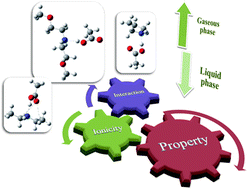Ionicity of acetate-based protic ionic liquids: evidence for both liquid and gaseous phases†
Abstract
Low ionicity at high temperatures has been detected for a series of acetate-based protic ionic liquids (PILs), which form neutral components as a result of back proton transfer through an equilibrium shift. By utilising temperature dependence of 15N NMR, neutral and ionised species are observed. In the meantime, 15N NMR and Attenuated Total Reflection Fourier Transform Infra Red (ATR-FTIR) spectroscopy indicates that the strength of directional hydrogen bonds is weakened at high temperatures, and ions form aggregates rather than precursor molecules. In situ FT-IR and gas chromatography-electron ionization mass spectrometry (GC-EI-MS) investigations show that the acetate-based PILs exist as both precursor molecules and ion pairs in the gaseous phase. Theoretical FT-IR vibrational mode analysis, the potential energy surface profile and Atom in Molecular (AIM) analysis of the PILs have been utilized to reveal the essential bonding information, which provides a guide for further application of the PILs.


 Please wait while we load your content...
Please wait while we load your content...